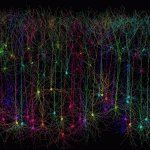
Düsum Khyenpa was a Tibetan master-level practitioner of lucid dream yoga. Image: Wikipedia
Brain areas that are usually switched off during deep sleep are active in lucid dreamers.
Lucid dreamers are aware of the state they are in and can deliberately perform actions and control events in their dreams. People who dream normally, on the other hand, have lower levels of brain activity during REM sleep and no awareness of the state of consciousness they are in.
Researchers from the Max Planck Institute of Psychiatry, Munich, and for Human Cognitive Brain Sciences, Leipzig, conducted a study where they looked at the cognitive features and brain activity of people who have lucid dreams. They were interested in comparing the brains of conscious and normal dreamers, with the aim of determining the neural correlates that allow lucid awareness to occur. A combined EEG/fMRI scanning approach was used to investigate the phenomenon.
“In normal dreams we have very basal consciousness, we experience perceptions and emotions but we are not aware that we are only dreaming,” explained Martin Dresler, lead author of the study published in the journal SLEEP. “It’s only in a lucid dream that the dreamer gets a meta-insight into his or her state.”
The neuroimaging data from the current study showed a network of frontal and prefrontal brain regions — which are responsible for higher cognitive control, awareness and emotional processing — was markedly activated within seconds of the participants reaching lucid consciousness. It should be noted, however, that the researchers only studied four subjects and only one of them had lucid REM sleep of a sufficient length to be analysed by fMRI.
The right dorsolateral prefrontal cortex was one of the main brain areas found to be involved in lucid awareness. This region is thought to have a role in a number of higher cognitive capacities including memory, decision-making and self-assessment. The researchers explained that activity in this area, combined with stimulation in the parietal lobules, is probably what gives lucid dreamers access to their working memory. The precuneus, a brain area linked to self-perception, was also especially active in people with lucid consciousness.
“These novel and challenging experiments provide intriguing insight into how brain activation may differ during lucid as compared to non-lucid dreaming,” says Danny Eckert from Neuroscience Research Australia, who was not involved in the study.
The researchers state in their paper that although lucid dreaming is an interesting phenomenon in its own right, it can also serve as a useful tool in studying dream disorders. They suggest that with further investigation, lucid dream training could be utilised as a treatment for people with a variety of disorders, such as recurrent nightmares, hypnagogic hallucinations and pathological dream vivification.

The brain regions that were activated more strongly in lucid compared to normal dreamers. Image: Science Daily
Source: Science Daily






